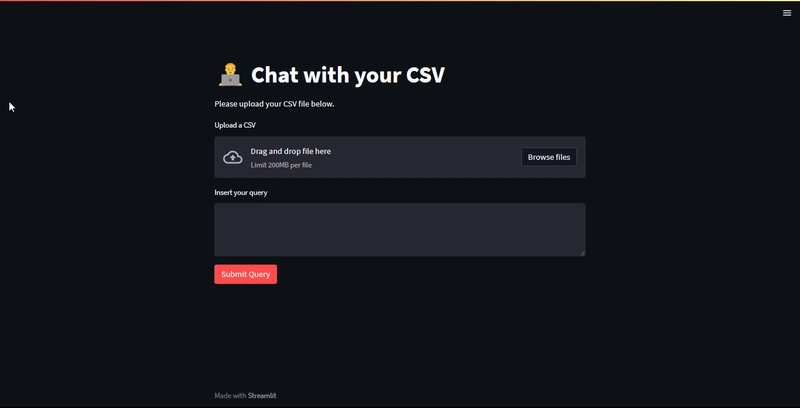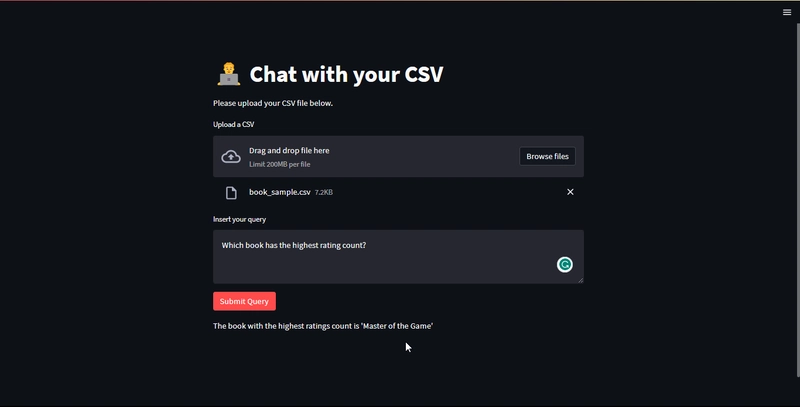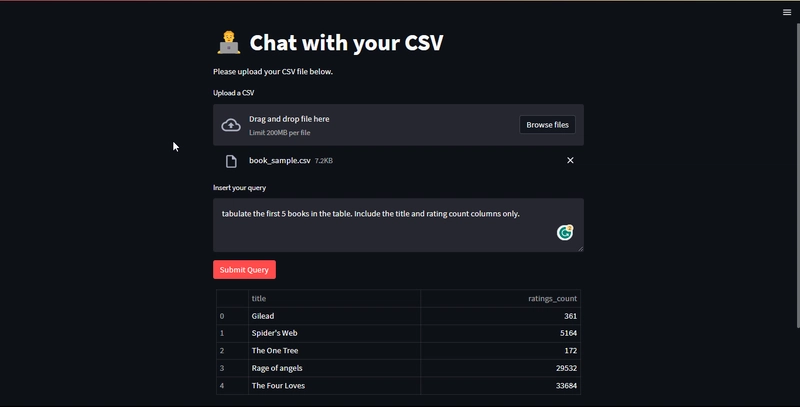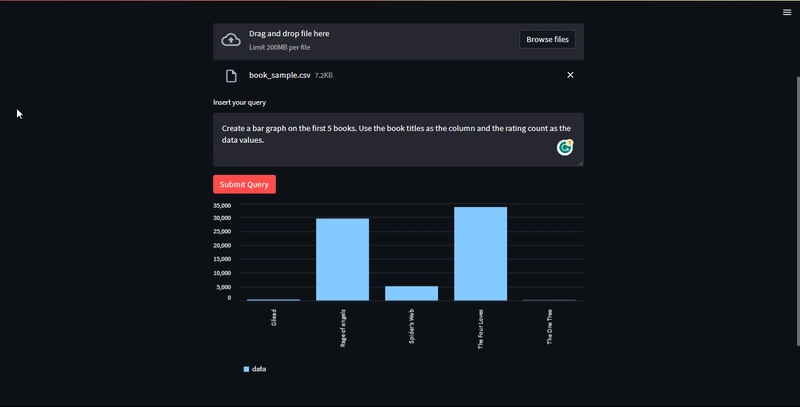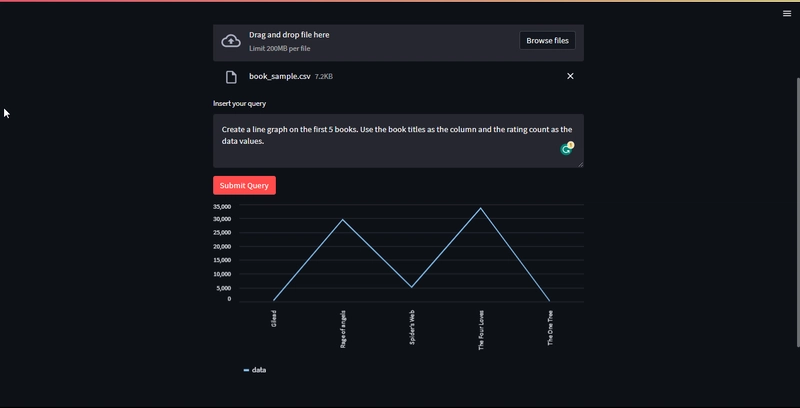使用您的 CSV 聊天:使用 Langchain 和 Streamlit 可视化您的数据
大型语言模型 (LLM) 的功能日益强大。这些模型可用于各种任务,包括生成文本、翻译语言和回答问题。
Langchain是一个 Python 模块,它使 LLM 的使用更加便捷。Langchain 提供了访问 LLM 的标准接口,并支持多种 LLM,包括 GPT-3、LLama 和 GPT4All。
在本文中,我将展示如何使用 Langchain 分析 CSV 文件。我们将使用 OpenAI API 访问 GPT-3,并使用 Streamlit 创建用户界面。用户可以上传 CSV 文件并提出有关数据的问题。系统随后会生成答案,并绘制表格和图表。
入门
首先,您需要安装langchain、openai和。您可以使用 pip 安装它们streamlit:python-environ
pip install langchain openai streamlit python-environ tabulate
设置代理
我已将该项目的所有代码包含在我的github上。
设置代理非常简单,因为我们将使用create_pandas_dataframe_agentlangchain 自带的。对于不熟悉的人来说,代理是一个可以访问和使用大型语言模型 (LLM) 的软件程序。代理负责接收用户输入、处理输入并生成响应。它们还可以访问和处理来自其他来源的数据,例如数据库、API 以及本例中的 csv 文件。
我们将使用该python-environ模块来管理 API 密钥。
创建一个.env文件并将密钥添加到其中,如下所示:
apikey=your_openai_api_key
创建一个名为的文件agent.py并添加以下代码:
# agent.py
from langchain import OpenAI
from langchain.agents import create_pandas_dataframe_agent
import pandas as pd
# Setting up the api key
import environ
env = environ.Env()
environ.Env.read_env()
API_KEY = env("apikey")
def create_agent(filename: str):
"""
Create an agent that can access and use a large language model (LLM).
Args:
filename: The path to the CSV file that contains the data.
Returns:
An agent that can access and use the LLM.
"""
# Create an OpenAI object.
llm = OpenAI(openai_api_key=API_KEY)
# Read the CSV file into a Pandas DataFrame.
df = pd.read_csv(filename)
# Create a Pandas DataFrame agent.
return create_pandas_dataframe_agent(llm, df, verbose=False)
该create_agent函数以 CSV 文件的路径作为输入,并返回一个可以访问和使用大型语言模型 (LLM) 的代理。该函数首先创建一个 OpenAI 对象,然后将 CSV 文件读入 Pandas DataFrame 中。最后,它创建一个 Pandas DataFrame 代理并返回它。
现在添加以下函数到agent.py:
#agent.py
# ...
def query_agent(agent, query):
"""
Query an agent and return the response as a string.
Args:
agent: The agent to query.
query: The query to ask the agent.
Returns:
The response from the agent as a string.
"""
prompt = (
"""
For the following query, if it requires drawing a table, reply as follows:
{"table": {"columns": ["column1", "column2", ...], "data": [[value1, value2, ...], [value1, value2, ...], ...]}}
If the query requires creating a bar chart, reply as follows:
{"bar": {"columns": ["A", "B", "C", ...], "data": [25, 24, 10, ...]}}
If the query requires creating a line chart, reply as follows:
{"line": {"columns": ["A", "B", "C", ...], "data": [25, 24, 10, ...]}}
There can only be two types of chart, "bar" and "line".
If it is just asking a question that requires neither, reply as follows:
{"answer": "answer"}
Example:
{"answer": "The title with the highest rating is 'Gilead'"}
If you do not know the answer, reply as follows:
{"answer": "I do not know."}
Return all output as a string.
All strings in "columns" list and data list, should be in double quotes,
For example: {"columns": ["title", "ratings_count"], "data": [["Gilead", 361], ["Spider's Web", 5164]]}
Lets think step by step.
Below is the query.
Query:
"""
+ query
)
# Run the prompt through the agent.
response = agent.run(prompt)
# Convert the response to a string.
return response.__str__()
函数query_agent是所有魔法发生的地方。该函数接受一个代理(Pandas DataFrame 代理)和一个查询作为输入,并以字符串形式返回代理的响应。该函数首先为代理创建一个提示。在这个提示中,我们指定所需的响应类型。我希望代理返回一个字符串,该字符串稍后会被转换为字典,并根据字典的内容,程序将渲染图形、表格或简单的文本响应。
设置streamlit界面
Streamlit是一个开源 Python 库,可轻松创建用于机器学习和数据科学的 Web 应用。Streamlit 的设计旨在快速易用,无需任何 JavaScript 或 CSS 知识即可创建美观的交互式应用。更多信息,请参阅文档。
Streamlit 相当容易使用。创建一个名为的文件interface.py并添加以下内容:
import streamlit as st
import pandas as pd
import json
from agent import query_agent, create_agent
def decode_response(response: str) -> dict:
"""This function converts the string response from the model to a dictionary object.
Args:
response (str): response from the model
Returns:
dict: dictionary with response data
"""
return json.loads(response)
该decode_response函数只是将代理的响应(字符串)转换为字典。
添加以下代码到interface.py:
#interface.py
#...
def write_response(response_dict: dict):
"""
Write a response from an agent to a Streamlit app.
Args:
response_dict: The response from the agent.
Returns:
None.
"""
# Check if the response is an answer.
if "answer" in response_dict:
st.write(response_dict["answer"])
# Check if the response is a bar chart.
if "bar" in response_dict:
data = response_dict["bar"]
df = pd.DataFrame(data)
df.set_index("columns", inplace=True)
st.bar_chart(df)
# Check if the response is a line chart.
if "line" in response_dict:
data = response_dict["line"]
df = pd.DataFrame(data)
df.set_index("columns", inplace=True)
st.line_chart(df)
# Check if the response is a table.
if "table" in response_dict:
data = response_dict["table"]
df = pd.DataFrame(data["data"], columns=data["columns"])
st.table(df)
此函数以响应字典作为输入,并将响应写入 Streamlit 应用。它可用于将答案、条形图、折线图和表格写入应用。
它首先检查响应是否为“答案”,也就是说,它是否只是针对诸如“文档中有多少行?”之类的问题的普通文本响应。如果是,该函数会将答案写入应用程序。
然后,该函数检查响应是否为条形图。如果是,该函数将根据响应中的数据创建一个条形图,并将其写入应用程序。
然后,该函数检查响应是否为折线图。如果是,该函数将根据响应中的数据创建折线图,并将该图表写入应用程序。
然后,该函数检查响应是否为表。如果是,则该函数根据响应中的数据创建一个表,并将该表写入应用程序。
最后,我们将创建初始界面。添加以下几行:
#interface.py
#...
st.title("👨💻 Chat with your CSV")
st.write("Please upload your CSV file below.")
data = st.file_uploader("Upload a CSV")
query = st.text_area("Insert your query")
if st.button("Submit Query", type="primary"):
# Create an agent from the CSV file.
agent = create_agent(data)
# Query the agent.
response = query_agent(agent=agent, query=query)
# Decode the response.
decoded_response = decode_response(response)
# Write the response to the Streamlit app.
write_response(decoded_response)
这段代码创建了一个 Streamlit 应用,允许用户使用 CSV 文件进行聊天。该应用首先要求用户上传一个 CSV 文件。然后,该应用要求用户输入查询。如果用户点击“提交查询”按钮,该应用将查询代理并将响应写入应用。
该应用程序使用以下功能:
create_agent():此功能从 CSV 文件创建代理。query_agent():此函数查询代理并返回响应。decode_response():此功能解码来自代理的响应。write_response():此功能将响应写入 Streamlit 应用程序。
让我们尝试一下吧!
现在在控制台中,使用 启动应用程序streamlit run interface.py。这将在浏览器中打开一个如下所示的窗口:
在本教程中,我将使用Kaggle上可以找到的书籍数据。上传你的 csv 文件,开始提示吧!
第一个问题:哪本书的评分最高?
显然,游戏大师的评分最高,我想我应该读一读。
第二个查询:列出前 5 本书。仅包含书名和评分计数列。
注意:我将列限制为标题和评级列,以便我们不超过 API 令牌限制。
第三个查询:创建前 5 本书的条形图
上面的查询将生成一个条形图。我指定了要使用的列,以便模型更容易理解我的查询。非常简洁。
第四个问题:创建前 5 本书的折线图
总而言之,Langchain 和 streamlit 是功能强大的工具,可以帮助会员轻松向 LLM 咨询数据。该应用程序允许会员获取可视化结果。对于想要进一步了解数据或需要帮助理解数据的用户来说,这是一个宝贵的资源。
如果您有任何疑问,请随时联系我们!
文章来源:https://dev.to/ngonidzashe/chat-with-your-csv-visualize-your-data-with-langchain-and-streamlit-ej7 后端开发教程 - Java、Spring Boot 实战 - msg200.com
后端开发教程 - Java、Spring Boot 实战 - msg200.com
